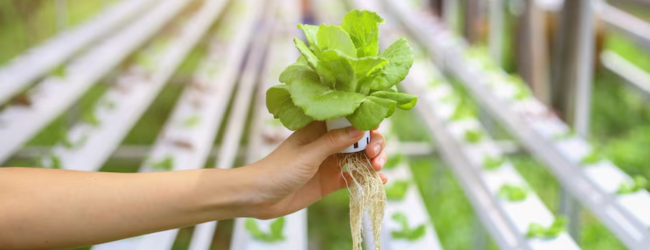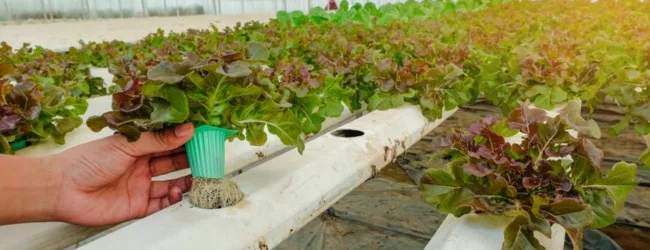Table of contents
- What is Aquaponics?
- Why is Aquaponics Farming Gaining Popularity in India?
- Production Techniques in Aquaponics
- Setting Up an Aquaponics System in India: Step-by-Step
- Setup Cost of Aquaponics Farming in India
- Profit Potential in Aquaponics Farming in India
- Advantages of Aquaponics Farming
- Challenges of Aquaponics Farming
- Conclusion
- Frequently Asked Questions (FAQs)
Aquaponics, an innovative and sustainable farming method, is gaining significant traction in India. By seamlessly integrating aquaculture (raising fish) and hydroponics (growing plants without soil), aquaponics offers a unique approach to food production that is both environmentally friendly and economically viable. This article delves deep into the world of aquaponics farming in India, exploring its production techniques, setup costs, potential profits, and much more.
What is Aquaponics?
At its core, aquaponics is a symbiotic relationship between fish and plants.
- Fish produce nutrient-rich waste: As fish eat and excrete, their waste products accumulate in the water.
- Water is circulated to plants: This nutrient-rich water is then channelled to the hydroponic system where plants absorb the nutrients as they grow.
- Plants filter the water: In the process of absorbing nutrients, the plants naturally filter the water, removing harmful waste products.
- Clean water returns to the fish: The cleaned water is then recirculated back to the fish tanks, creating a closed-loop system.
This ingenious system minimises water usage, eliminates the need for chemical fertilisers and pesticides, and can significantly increase food production per unit area.
Why is Aquaponics Farming Gaining Popularity in India?

Several factors contribute to the growing interest in aquaponics farming in India:
- Water Scarcity: India faces increasing water stress, making water-efficient farming methods like aquaponics highly attractive. Traditional agriculture consumes vast amounts of water.
- Land Limitations: With a growing population and shrinking arable land, aquaponics offers a way to produce food in smaller spaces, even in urban environments.
- Chemical-Free Food: Consumers are increasingly demanding organically grown, chemical-free produce, which aquaponics naturally provides.
- Potential for High Yields: Aquaponics systems can produce significantly higher yields compared to conventional farming per unit area.
- Government Support: The Indian government is increasingly promoting sustainable agriculture through various schemes and subsidies, which can benefit aquaponics farmers.
- Entrepreneurial Opportunities: Aquaponics presents a promising business opportunity for individuals and communities looking for innovative income-generating activities.
💡 Pro Tip: If you want to start a farming business but have too many doubts, connect with a farming business expert from Boss Wallah for guidance – Check Out
Production Techniques in Aquaponics
Several production techniques can be employed in aquaponics farming in India, each with its own advantages and considerations:
Deep Water Culture (DWC) or Raft System:
- Plants are grown in Styrofoam rafts that float on the nutrient-rich water.
- Roots are submerged in the water, allowing for efficient nutrient uptake.
- Suitable for leafy greens like lettuce, spinach, and herbs.
Highlight: Relatively simple to set up and manage.
Nutrient Film Technique (NFT):
- A shallow stream of nutrient-rich water flows through channels, and plant roots are suspended in this film.
- Requires a slight slope for proper water flow.
- Well-suited for smaller plants like strawberries, herbs, and some vegetables.
Example: Several urban aquaponics startups in India use NFT systems to grow and sell fresh herbs.
Media Beds:
- Grow beds are filled with an inert medium like clay pebbles or lava rock.
- The nutrient-rich water is periodically flooded and drained from the beds, providing nutrients and oxygen to the plant roots.
- Suitable for a wide variety of plants, including fruiting vegetables like tomatoes, peppers, and cucumbers.
Highlight: Provides good support for larger plants.
Vertical Towers:
- Plants are grown in vertical towers with nutrient-rich water flowing down through them.
- Maximises space utilisation, making it ideal for urban farming.
- Suitable for leafy greens, strawberries, and herbs.
Example: Some innovative farmers in metropolitan cities are using vertical aquaponics to cater to local restaurant demands.
The choice of technique depends on factors like available space, budget, type of plants and fish being raised, and the farmer’s expertise.
Setting Up an Aquaponics System in India: Step-by-Step

Setting up an aquaponics farming in India involves careful planning and execution. Here’s a general step-by-step guide:
Planning and Design:
- Determine the scale of your operation (small-scale, commercial).
- Choose the production technique that best suits your needs.
- Design the layout of your system, considering space, sunlight, and accessibility.
- Decide on the types of fish and plants you want to grow. Tilapia and leafy greens are popular choices for beginners in India due to their fast growth rates and adaptability.
Component Selection:
- Fish Tank: Choose a food-grade tank of appropriate size. Plastic or fibreglass tanks are commonly used.
- Grow Bed/Channels/Towers: Select based on your chosen production technique.
- Water Pump: A submersible pump is needed to circulate water between the fish tank and the grow beds.
- Air Pump and Air Stone: Essential for oxygenating the water for the fish.
- Plumbing: Pipes and fittings to connect the different components. PVC pipes are commonly used.
- Growing Media (if using media beds): Clay pebbles or lava rock.
- Net Pots/Rafts (for DWC/NFT): To hold the plants.
- Testing Kits: To monitor water parameters like pH, ammonia, nitrite, and nitrate levels.
System Assembly:
- Position the fish tank and grow beds in the desired location, ensuring a level surface.
- Connect the plumbing to circulate water between the tank and grow beds.
- Install the water pump and air pump.
- Fill the fish tank with water and dechlorinate it if necessary.
Cycling the System:
- This crucial step establishes a beneficial bacteria colony that converts fish waste into plant nutrients.
- Add a source of ammonia (fish food or pure ammonia) to the tank.
- Monitor ammonia, nitrite, and nitrate levels daily using testing kits.
- The cycling process typically takes 4-6 weeks. Ammonia levels will spike, then drop as nitrifying bacteria convert it to nitrite. Nitrite levels will then spike and drop as other bacteria convert it to nitrate, which is usable by plants.
Introducing Fish:
- Once the system is fully cycled (ammonia and nitrite levels are zero), gradually introduce a small number of fish.
- Start with a low stocking density and increase it over time as the system matures.
- Common fish choices in India include Tilapia, Catfish, and Rohu.
Planting:
- Once the fish are established and nitrate levels are sufficient, you can start planting seedlings in the grow beds or rafts.
- Ensure the pH of the water is suitable for both fish and plants (typically between 6.0 and 7.0).
Monitoring and Maintenance:
- Regularly test water parameters (pH, ammonia, nitrite, nitrate).
- Maintain adequate water levels.
- Provide appropriate feed to the fish.
- Monitor plants for any signs of nutrient deficiencies or pests.
- Perform periodic cleaning of the fish tank and grow beds.
Setup Cost of Aquaponics Farming in India
The setup cost of aquaponics farming in India can vary significantly depending on the scale and complexity of the system. Here’s a general breakdown:
Small-Scale/Backyard System (for personal use or small-scale sales):
- Fish tank (500-1000 litres): ₹5,000 – ₹15,000
- Grow bed/channels: ₹3,000 – ₹10,000
- Water pump, air pump, and plumbing: ₹2,000 – ₹5,000
- Growing media/net pots: ₹1,000 – ₹3,000
- Total estimated cost: ₹11,000 – ₹33,000
Commercial System (for significant production and sales):
- Multiple large fish tanks (several thousand litres each): ₹50,000 – ₹2,00,000+
- Extensive grow bed/NFT channel/vertical tower systems: ₹40,000 – ₹1,50,000+
- High-capacity water pumps, air pumps, and robust plumbing: ₹15,000 – ₹50,000+
- Greenhouse structure (optional but recommended for climate control): ₹50,000 – ₹3,00,000+
- Water quality monitoring equipment, filtration systems: ₹10,000 – ₹30,000+
- Total estimated cost: ₹1,65,000 – ₹7,30,000+ (can be higher depending on the scale)
Factors influencing the setup cost:
- Size of the system: Larger systems require more materials and labour.
- Type of materials used: High-quality, durable materials will cost more upfront but can save money in the long run.
- Automation: Automated systems for water circulation, feeding, and monitoring will increase the initial cost but can reduce labour.
- Location: Transportation costs of materials can vary.
- Labour costs: If you hire labour for setup, it will add to the cost.
It’s crucial to develop a detailed business plan and budget before investing in an aquaponics system. Exploring government subsidies and loans for sustainable agriculture can also help reduce the initial financial burden.
Profit Potential in Aquaponics Farming in India

The profit potential in aquaponics farming in India can be significant, but it depends on several factors:
- Scale of Operation: Larger commercial systems have the potential for higher overall profits.
- Choice of Fish and Plants: High-value crops and fish species can generate better returns. For instance, growing organic gourmet vegetables or raising ornamental fish alongside edible varieties can increase profitability.
- Market Demand and Pricing: Identifying niche markets for organically grown produce and fresh fish can command premium prices. Direct sales to restaurants and consumers can also improve profit margins.
- Operational Efficiency: Efficient water and energy management, minimising waste, and optimising production cycles are crucial for profitability.
- Marketing and Sales: Effective marketing strategies to reach target customers are essential.
- Input Costs: Managing costs related to fish feed, electricity, and other inputs is important.
Real Business Examples (Illustrative):
- A small-scale urban aquaponics farm in Bangalore, focusing on supplying fresh basil and lettuce to local restaurants, reports a monthly revenue of ₹30,000 – ₹50,000 with careful cost management.
- A larger commercial aquaponics farm near Chennai, growing Tilapia and a variety of vegetables for the local market, aims for an annual turnover of ₹10-₹15 lakhs after the initial stabilisation period.
Key factors for maximising profit:
- Produce high-quality, organic food: This can command premium prices.
- Diversify your crops and fish: This can reduce market risks and cater to a wider customer base.
- Develop direct marketing channels: Selling directly to consumers or restaurants can eliminate middlemen and increase profits.
- Implement efficient resource management: Minimise water and energy consumption.
- Continuously learn and adapt: Stay updated on the latest aquaponics techniques and market trends.
ALSO READ | Contract Farming in India: Meaning, How to Start, Benefits & More
Advantages of Aquaponics Farming
Aquaponics farming offers numerous advantages, making it a sustainable and attractive option:
- Water Conservation: Uses significantly less water (up to 90% less) compared to traditional agriculture.
- No Soil Required: Eliminates soil-borne diseases and the need for weeding.
- No Chemical Fertilisers or Pesticides: Produces healthy, organic food.
- Higher Yields: Can produce more food per unit area compared to conventional farming.
- Faster Growth Rates: Plants often grow faster in aquaponic systems due to the readily available nutrients.
- Dual Income Stream: Generates income from both fish and plant production.
- Environmentally Friendly: Reduces agricultural runoff and the carbon footprint associated with traditional farming.
- Suitable for Urban Farming: Can be implemented in areas with limited land.
- Year-Round Production: With controlled environments like greenhouses, production can continue throughout the year.
Challenges of Aquaponics Farming
While aquaponics offers many benefits, it also presents certain challenges:
- Initial Setup Cost: Can be higher than traditional farming, especially for commercial systems.
- Technical Knowledge Required: Requires understanding of both aquaculture and hydroponics.
- System Balancing: Maintaining the delicate balance between fish and plants is crucial.
- Water Quality Management: Regular monitoring and adjustment of water parameters are essential.
- Energy Consumption: Pumps require electricity to circulate water and aerate the system.
- Fish Diseases: Fish are susceptible to diseases, which can impact the entire system.
- Algae Growth: Can be an issue in outdoor systems.
ALSO READ | Commercial Farming in India: Types, Advantages, Challenges & More
Need Expert Guidance?
Starting a business can be challenging, but you don’t have to do it alone! At Boss Wallah, our 2,000+ business experts are ready to provide valuable insights and guidance. Whether you need help with marketing, finance, sourcing, or any other area of any business, our business experts are here to help you succeed – Check Out
Confused about Which Business to Start?
Want to start your own business but unsure which one to choose? Explore Boss Wallah, where you’ll find 500+ courses by successful business owners, featuring practical, step-by-step guides on starting and growing various businesses.
Find your perfect business idea today – Check Out
Conclusion
Aquaponics farming in India holds immense potential for sustainable food production, offering solutions to water scarcity, land limitations, and the growing demand for organic food. While the initial setup requires investment and technical know-how, the long-term benefits, including water efficiency, higher yields, and the production of chemical-free food, make it an increasingly attractive option for farmers and entrepreneurs.
As awareness and adoption of aquaponics grow, it is poised to play a significant role in shaping the future of agriculture in India. Highlight: The synergistic relationship between fish and plants makes aquaponics a truly innovative and sustainable food production system.
Frequently Asked Questions (FAQs)
- What types of fish are best for aquaponics in India?
Tilapia, Catfish, and Rohu are popular choices due to their fast growth and adaptability. - What plants grow well in Indian aquaponic systems?
Leafy greens like lettuce, spinach, herbs (basil, mint), and fruiting vegetables like tomatoes, peppers, and cucumbers can thrive. - How much space do I need for a small aquaponics system?
A basic backyard system can be set up in an area of 50-100 square feet. - How often do I need to feed the fish?
Typically, once or twice a day, depending on the size and type of fish. - How often do I need to change the water in an aquaponics system?
Aquaponics is a closed-loop system, so you generally don’t need to change the water. You only need to top it off to replace water lost through evaporation. - Is aquaponics farming organic?
Yes, when done correctly, aquaponics is considered an organic farming method as it avoids synthetic fertilisers and pesticides. - How long does it take to see a return on investment in aquaponics?
It varies depending on the scale and efficiency of the operation, but typically it can take 1-3 years. - Do I need a lot of electricity for an aquaponics system?
Electricity is needed for pumps. Optimising pump size and using energy-efficient models can help minimise energy consumption. Solar power can also be an option. - What are the common challenges faced in aquaponics?
Maintaining water quality balance, managing fish diseases, and initial setup costs are common challenges. - Where can I get training on aquaponics farming in India?
Several agricultural universities, research institutions, and private organisations in India offer training programs and workshops on aquaponics. Online resources and communities are also available.



